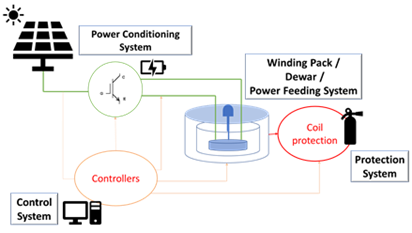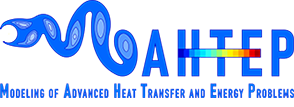Preconceptual design, development (and experiment) of a superconducting test magnet for energy storage system
Activity carried out within the MSc thesis project of Simone Sparacio (tutored by Prof. Laura Savoldi and Prof. Francesco Laviano).
Objective of the activity:
The general aim of this work is the investigation of the electromagnetic model for describing the electrical and magnetic response of high temperature superconducting (HTS) materials that are suitable for power applications and the integration these relations into existing multi-physics models for the design of a small Superconductive Magnetic Energy Storage (SMES). The SMES will be built and tested at DISAT premises, allowing the critical assessment of the capability of the numerical models used for the SMES design.
Framework of the activity:
The progressively increasing penetration of electricity from solar photovoltaic plants, needed for a successful deployment of renewable energy sources, strongly depends on the economic cost of system integration, that should also mitigate the intermittency of PV electricity. Among the different available energy storage systems that could be applied to compensate the fluctuating PV power, Superconductive Magnetic Energy Storage (SMES) are attractive because of their high deliverable power and efficiency, and their virtually infinite number of charge-discharge cycles without degradation.

Figure 1. SMES components identification.
Planned activity:
Here, the concept is to design of a module for a 10 MW toroidal YBCO SMES, with a charge/discharge time of 1 s, including the superconducting coil, the power feeding system, and the cryogenic cooling. The design has been performed with a functional analysis approach, translating the system-level requirements into detailed functional and performance requirements for the sub-components, imposing a maximum value for the module radius of 0.5 m and a maximum magnetic self-field of 4 T. The ampere-turn design is based on a stack of 7 commercial 12 mm-width 2G YBCO tapes, with a nominal current of 330 A at 77 K, so that conservatively a total effective current of 1kA at 50 K can be retained for the stack.
For the winding pack of a single module, the optimized design points to a multi-layer coil with radius ~ 0.45 m, wound using 52 layers in parallel, each with 26 turns, with a total inductance of ~2 H and a maximum self-field below 4 T. Nine modules are needed for the entire SMES. Such design is checked by a detailed 2D axisymmetric electro-magnetic model, purposely developed in COMSOL Multiphysics®. The conceptual design of the cryostat is also considered, focusing on the thermal insulation and the cryocooler.


